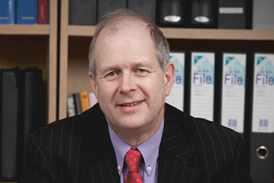Alistair Logan provides a powerful account of the disturbing consequences of the enforced closure of the Forensic Science Service (FSS). We, who were members of the FSS until its closure, write to amplify the concerns that he expressed.
The most worrying aspect of the whole sorry tale is the clear message that mainstream provision of forensic science in England and Wales is directed exclusively by police priorities, without consideration of the needs of the wider criminal justice system (CJS). The decision to close the FSS was taken on financial projections of police expenditure on forensic science. A fall in demand was predicted as a result of more work being carried out by in-force facilities and this process is well under way. There are several reasons why this is an undesirable development.
Police priorities are cost and timeliness. Cost is the overriding determinant but it is easy to see that an investigator needs any information that can assist his enquiries as quickly as possible. It is also clear that the police regard forensic science as largely a matter of carrying out tests. But this is misguided because the results of the tests are rarely clear-cut and their interpretation within the circumstances of each particular case requires specialist knowledge and understanding. This is where the science lies: the provision of a balanced and reasoned view about what the results of any testing mean.
In the 1990s, an FSS project was initiated called Case Assessment and Interpretation (CAI) with the aim: ‘To enable decisions to be made which will deliver a value-for-money service meeting the needs of our direct customers and the CJS.’
Our ‘direct customers’ were, of course, the police but the team was conscious of our overriding responsibilities to society in general and the CJS in particular. The groundbreaking work that emanated from this project was recognised internationally in publications and prizes; the principles that were established – balance, logic, robustness and transparency – have been adopted as policy by the European Network of Forensic Science Institutes (ENFSI). One benefit of the project was a clarification of two roles for the forensic scientist: investigator and evaluator.
There is no doubting the importance of each and, although there is a degree of overlap, there is a clear distinction between responsibilities of the two. In the first, the scientist is part of a police process for identifying offenders. In the second, the scientist is the provider of information and opinion to the judicial process. Whereas in the first partiality with regard to police procedures is expected, in the second it is highly undesirable. Opinions and forms of expression in the investigative role may be quite unacceptable in the evaluative role. Assiduity in narrowing the focus of enquiry to a single suspect in the former role must be put aside in the latter, where the function is that of weighing evidence in relation to the positions of both prosecution and defence.
If we learned all of our forensic science from our televisions we could be forgiven for believing that DNA profiling is a straightforward open and shut process. How often do we hear ‘it's his DNA on the gun, guv’? The reality is considerably more nuanced and, for example, when the DNA is a mixture from two or more individuals the evaluation may become highly complex. Consider the following example of what is widespread reporting practice in statements prepared for the CPS by Forensic Service Providers (FSPs) in the UK: ‘Components in the DNA profile from the crime sample match the suspect's profile and could have come from him.’ Innocuous enough? Well, it is also true that those components could have come from someone else – so the full sentence should read: ‘Components in the DNA profile from the crime sample match the suspect's profile and could have come from him or could have come from someone else.’ This latter sentence, while it may be true, is useless for conveying any indication of weight of evidence but at least it is balanced, whereas the former is prosecution-biased.
Consider the following: ‘The DNA profile from the handgun matches that of the suspect; the chance that some unknown person unrelated to the suspect would have the same profile is one in a billion.’ Again, this is virtually standard practice. But why does the second part of the sentence specify some ‘unknown person unrelated to the suspect’? If the DNA had come from a close relative of the suspect then the chance of a match would be much greater than one in a billion – perhaps one in 10,000.
Why not give that alternative? The reality is that the choice of an unrelated person for the alternative maximises the weight of evidence against the suspect. A balanced approach would not do this: indeed a balanced approach would not offer any evaluative opinion, or statistic, unless the circumstances of the case implied a clear defence alternative. Of course, in most cases these kinds of examples do not have serious consequence but over the years there is no doubt that expert prosecution bias has been a factor in miscarriages of justice. While the police are paying for evaluative opinions there is not going to be any progression to the kind of balanced structure that the CAI approach fostered.
Alastair Logan rightly pointed out the dangers of fragmentation in the provision of forensic science, which were graphically illustrated recently in the trial and acquittal of David Butler (Liverpool CC, URN: 05E10311011). In that case, in addition to the scenes of crime officers who took exhibits, three different agencies were involved in the DNA profiling: two FSPs and an academic statistician. There were four primary issues of concern in the case:
1. Undue significance was given to DNA recovered from fingernail clippings: poor handover between FSPs led to incorrect assumptions about the DNA being from under the nails.
2. The statistical analysis was carried out using unvalidated software, with no clear agreement on how the DNA profiles should be interpreted between the FSP and the academic.
3. The suspect’s was one of three names identified through a speculative search of the National DNA Database. Police commissioned the scientist to evaluate whether the other two individuals could have contributed to other DNA profiles in the case: using appropriate logic, the scientist concluded that neither was likely to have been a contributor to these profiles.
However, the scientist did not carry out the same check for David Butler, because she had not been instructed by the police to do so. When this check was later carried out on behalf of David Butler’s defence team, using the same logic, he too was unlikely to have contributed to the profiles.
4. Crucial information about a medical condition affecting the likelihood of the defendant transferring unusually large amounts of DNA was not passed on to the scientist, who was asked to give an opinion on the possible routes of DNA transfer.
So not only were there quality issues about how results were passed from one agency to another, but the failure to pass on crucially relevant information resulted in the evidential evaluation being based on an incorrect and incomplete perception of the case circumstances and the defence position. With the present systems as they are – in particular a test-based culture imposed by police requirements – this kind of problem is going to arise regularly.
Nor is this the only problem: initial examination of items by individuals such as police armourers, who are usually not trained in trace evidence recovery, can impair the effective development of a cogent forensic strategy. A consequence would be the loss or compromise of valuable trace evidence such as DNA, fibres or gunshot residue: any of which might be relevant to whether a given suspect was involved. CAI is important for the assessment and consideration of potential contamination and, given the fragmentation of provision, this becomes a much more difficult issue to address.
We are aware of problems even within the provision of test results, such as misidentification of drugs and misclassification of firearms, and of problems in the interpretation of results at the level required for court purposes. If the court is concerned with who owned an item, and the FSP reports only on the presence of an individual’s DNA profile on that item, there is a real danger that the two will be equated, when in fact they are very different issues.
The need for independent scrutiny and reappraisal of evaluative forensic science has never been so great. Alastair Logan pointed out the potential for loss of knowledge following the closure of the FSS; certainly, we are aware of many experienced scientists who have left the profession altogether.
We have spent decades striving to raise standards in forensic science: we do not intend to allow such standards to slip without challenge.
Dr Ian Evett, Dr Sue Pope and Dr Gillian Tully are scientists at Principal Forensic Services



























No comments yet